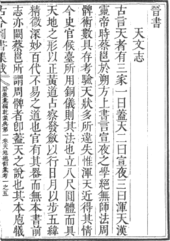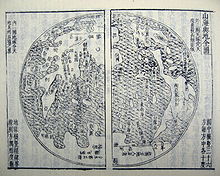22:
131:
263:
86:
are composed of sometimes lengthy citations from other works, and often contain copies of entire works, not just excerpts. The works are classified by a systematic set of categories, which are further divided into subcategories.
361:
were compiled, from the Cao Wei period (early third century) until the 18th century, of which 200 have survived. Among the most important, in chronological order, are:
243:
331:
have played an important role in the preservation of ancient works, many of which have been lost, only preserved completely or partially as part of a
377:
349:
also provide a unique view of the transmission of knowledge and education, and an easy way to locate traditional materials on any given subject.
239:
elite, were also compiled in the later imperial era. Today, they provide scholars with valuable information on non-elite culture and attitudes.
430:
449:
212:
118:
27:
389:
341:
is especially valuable. It contains excerpts from 1,400 pre-7th century works, 90% of which have been otherwise lost. Even though the
425:
71:
historically compiled in China and other East Asian countries. The term is generally translated as "encyclopedia", although the
693:
670:
646:
95:, but are encyclopedic in the sense that they may comprise the entire realm of knowledge at the time of compilation.
102:
were compiled from the early third century until the eighteenth century, of which 200 have survived. The largest
224:
ever printed, containing 100 million characters and 852,408 pages. It was compiled by a team of scholars led by
728:
723:
46:
54:
235:(encyclopedias for daily use), containing practical information for people who were literate but below the
345:
is itself largely lost, the remnants still contain 385 complete books that have been otherwise lost. The
21:
733:
185:, in which entire works, rather than excerpts, were copied and classified by category. The largest
406:
681:
660:
207:. It was completed in 1408, but never printed, as the imperial treasury had run out of money.
636:
181:, emperors sponsored monumental projects to compile all known human knowledge into a single
718:
8:
475:
393:(初學記,Writings for elementary instruction), compiled by Xu Jian et al. between 713 and 742
267:
108:
656:
200:
159:
113:
203:. The project involved 2,169 scholars, who worked for four years under general editor
689:
666:
642:
305:
130:
713:
247:
148:
The genre first appeared in the early third century. The earliest known was the
190:
68:
707:
437:
397:
204:
195:
136:
413:
289:
272:
225:
167:
76:
418:
366:
337:
262:
92:
371:
382:
236:
417:(Outstanding models from the storehouse of literature), compiled by
150:
250:(1796–1820) of the Qing dynasty saw the end of the publication of
155:
370:(Collection of literature arranged by categories), compiled by
381:(北堂书钞 ,Excerpts from books in the Northern Hall), compiled by
228:, and printed between 1726 and 1728, during the Qing dynasty.
316:
521:
519:
517:
515:
178:
174:
586:
584:
582:
569:
567:
565:
540:
538:
536:
534:
611:
512:
579:
562:
550:
531:
283:
Other countries in East Asia also adopted the genre of
122:, containing 100 million characters and 852,408 pages.
601:
599:
502:
500:
309:. The Japanese version was edited by Terajima Ryōan (
303:) in the early 17th century, was printed in Japan as
682:"Fifteen hundred years of the Chinese encyclopaedia"
596:
497:
154:("Emperor's mirror"). Sponsored by the emperor of
638:China in European Encyclopaedias, 1700–1850
705:
686:Encyclopaedism from Antiquity to the Renaissance
173:In later imperial China dynasties, such as the
310:
75:are quite different from the modern notion of
450:Complete Classics Collection of Ancient China
298:
213:Complete Classics Collection of Ancient China
119:Complete Classics Collection of Ancient China
28:Complete Classics Collection of Ancient China
158:, it was compiled around 220, but has since
62:
679:
525:
655:
617:
590:
573:
556:
544:
261:
129:
67:'category books') is a genre of
20:
116:, and the largest ever printed was the
706:
634:
605:
506:
352:
257:
189:ever compiled, on the order of the
13:
665:. Harvard University Asia Center.
297:compiled by Ming scholar Wang Qi (
199:containing a total of 370 million
16:Sinosphere genre of reference work
14:
745:
429:(玉海,Ocean of jade), compiled by
680:Zurndorfer, Harriet T. (2013).
688:. Cambridge University Press.
627:
468:
441:, completed 1408, the largest
58:
50:
1:
485:
335:compilation. The 7th-century
322:
490:
7:
478:" in the Western tradition.
218:Qinding Gujin Tushu Jicheng
106:ever compiled was the 1408
10:
750:
125:
662:Chinese History: A Manual
421:et al., completed in 1013
311:
299:
112:, containing 370 million
461:
220:) is by far the largest
453:, 1726–28, the largest
403:Taiping Imperial Reader
315:), a physician born in
293:, a richly illustrated
266:The world map entitled
166:was not used until the
635:Lehner, Georg (2011).
280:
145:
36:
729:Chinese encyclopedias
724:Chinese classic texts
409:et al., published 984
265:
133:
24:
162:. However, the term
657:Wilkinson, Endymion
476:speculum literature
474:Compare the later "
268:Shanhai Yudi Quantu
109:Yongle Encyclopedia
47:traditional Chinese
357:Approximately 600
353:Major compilations
281:
258:In other countries
201:Chinese characters
146:
114:Chinese characters
98:Approximately 600
91:may be considered
55:simplified Chinese
37:
695:978-1-107-47089-7
672:978-0-674-00249-4
648:978-90-04-20150-7
620:, pp. 603–5.
276:, an illustrated
244:Jean-Pierre Diény
193:of Ming, was the
65:
741:
699:
676:
652:
621:
615:
609:
603:
594:
588:
577:
571:
560:
554:
548:
542:
529:
523:
510:
504:
479:
472:
314:
313:
306:Wakan Sansai Zue
302:
301:
66:
63:
60:
52:
25:A page from the
749:
748:
744:
743:
742:
740:
739:
738:
734:Reference works
704:
703:
702:
696:
673:
649:
630:
625:
624:
616:
612:
604:
597:
589:
580:
572:
563:
555:
551:
543:
532:
526:Zurndorfer 2013
524:
513:
505:
498:
493:
488:
483:
482:
473:
469:
464:
405:), compiled by
378:Beitang Shuchao
355:
325:
287:. In 1712, the
260:
128:
69:reference books
17:
12:
11:
5:
747:
737:
736:
731:
726:
721:
716:
701:
700:
694:
677:
671:
653:
647:
631:
629:
626:
623:
622:
618:Wilkinson 2000
610:
595:
593:, p. 602.
591:Wilkinson 2000
578:
576:, p. 605.
574:Wilkinson 2000
561:
559:, p. 603.
557:Wilkinson 2000
549:
547:, p. 604.
545:Wilkinson 2000
530:
528:, p. 505.
511:
495:
494:
492:
489:
487:
484:
481:
480:
466:
465:
463:
460:
459:
458:
446:
434:
422:
410:
394:
386:
374:
354:
351:
324:
321:
259:
256:
191:Yongle Emperor
140:, the largest
127:
124:
31:, the largest
15:
9:
6:
4:
3:
2:
746:
735:
732:
730:
727:
725:
722:
720:
717:
715:
712:
711:
709:
697:
691:
687:
683:
678:
674:
668:
664:
663:
658:
654:
650:
644:
640:
639:
633:
632:
619:
614:
608:, p. 47.
607:
602:
600:
592:
587:
585:
583:
575:
570:
568:
566:
558:
553:
546:
541:
539:
537:
535:
527:
522:
520:
518:
516:
509:, p. 46.
508:
503:
501:
496:
477:
471:
467:
456:
452:
451:
447:
445:ever compiled
444:
440:
439:
438:Yongle Dadian
435:
432:
428:
427:
423:
420:
416:
415:
411:
408:
404:
400:
399:
398:Taiping Yulan
395:
392:
391:
387:
384:
380:
379:
375:
373:
369:
368:
364:
363:
362:
360:
350:
348:
344:
343:Yongle Dadian
340:
339:
334:
330:
320:
318:
308:
307:
296:
292:
291:
286:
279:
275:
274:
269:
264:
255:
253:
249:
248:Jiaqing reign
245:
242:According to
240:
238:
234:
233:riyong leishu
229:
227:
223:
219:
215:
214:
208:
206:
205:Yao Guangxiao
202:
198:
197:
196:Yongle Dadian
192:
188:
184:
180:
176:
171:
169:
165:
161:
157:
153:
152:
144:ever compiled
143:
139:
138:
137:Yongle Dadian
132:
123:
121:
120:
115:
111:
110:
105:
101:
96:
94:
90:
85:
80:
78:
74:
70:
56:
48:
44:
43:
34:
30:
29:
23:
19:
685:
661:
637:
613:
552:
470:
457:ever printed
454:
448:
442:
436:
431:Wang Yinglin
424:
414:Cefu Yuangui
412:
402:
396:
388:
376:
365:
358:
356:
346:
342:
336:
332:
328:
326:
304:
294:
290:Sancai Tuhui
288:
284:
282:
277:
273:Sancai Tuhui
271:
251:
241:
232:
230:
226:Chen Menglei
221:
217:
211:
209:
194:
186:
182:
172:
170:(960–1279).
168:Song dynasty
163:
149:
147:
141:
135:
117:
107:
103:
99:
97:
88:
83:
81:
77:encyclopedia
72:
41:
40:
38:
35:ever printed
32:
26:
18:
719:Anthologies
628:Cited works
606:Lehner 2011
507:Lehner 2011
419:Wang Qinruo
367:Yiwen Leiju
338:Yiwen Leiju
270:, from the
93:anthologies
708:Categories
486:References
372:Ouyang Xun
323:Importance
641:. BRILL.
491:Citations
390:Chuxue Ji
383:Yu Shinan
237:Confucian
160:been lost
659:(2000).
151:Huanglan
433:1330–40
407:Li Fang
385:ca. 630
156:Cao Wei
126:History
714:Leishu
692:
669:
645:
455:leishu
443:leishu
359:leishu
347:leishu
333:leishu
329:leishu
295:leishu
285:leishu
278:leishu
252:leishu
246:, the
222:leishu
187:leishu
183:leishu
164:leishu
142:leishu
104:leishu
100:leishu
89:Leishu
84:leishu
73:leishu
57::
49::
42:leishu
33:leishu
462:Notes
426:Yuhai
317:Osaka
690:ISBN
667:ISBN
643:ISBN
327:The
312:寺島良安
231:The
210:The
179:Qing
177:and
175:Ming
134:The
82:The
64:lit.
39:The
710::
684:.
598:^
581:^
564:^
533:^
514:^
499:^
319:.
300:王圻
254:.
79:.
61:;
59:类书
53:;
51:類書
698:.
675:.
651:.
401:(
216:(
45:(
Text is available under the Creative Commons Attribution-ShareAlike License. Additional terms may apply.


